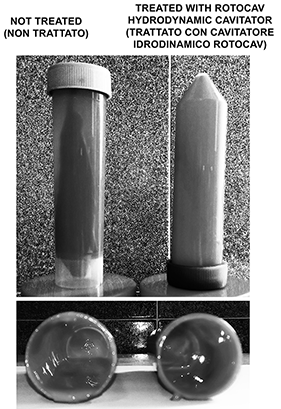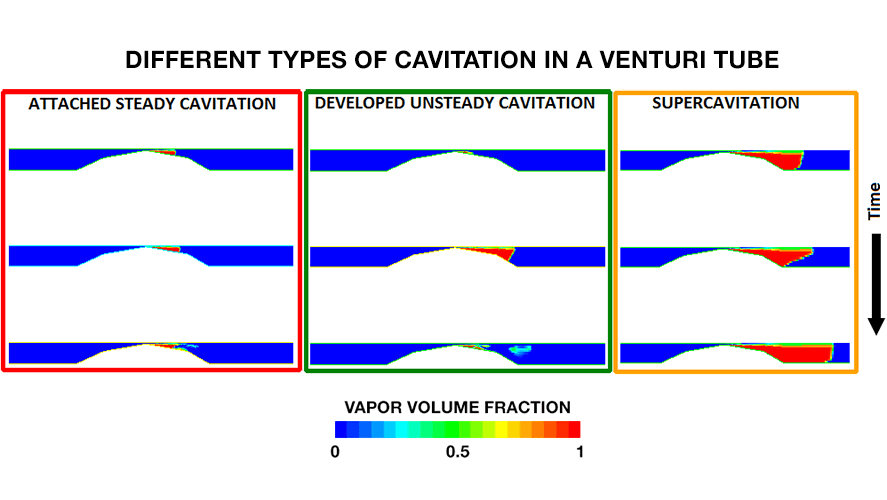Blog - Cavitation and process intensification - p3
20/03/2018
Hydrodynamic cavitation to treat pigments for the paint and coatings industries

Have you ever heard of the treatment of pigments and dyes by hydrodynamic cavitation for the paint and coatings industries? Do you work in such industries and you are experiencing issues in homogenization and dispersing? We tested our ROTOCAV hydrodynamic cavitator to treat pigments, to be able to obtain a more uniform particle size distribution in the nano and micron ranges and improve the quality of colors, paints and coatings.
Our test was able to decrease the particle size, with a narrow particle size distribution curve and to effectively homogenize and disperse the pigments into the liquid medium.
The treatment increased also the stability of the dispersion, with no sedimented residues and agglomerates after one month of storage.
Why treating pigments with hydrodynamic cavitation? Liquid jets and cavitational shear stresses are able to break up the solids and you will have better color saturation, stability, consistency and wettability!


19/01/2018
ROTOCAV compared to other commercial hydrodynamic cavitators

Hydrodynamic cavitation can be generated by static or dynamic elements.
In static elements, such as venturi tubes or perforated plates, pressure energy is converted to kinetic energy, or in other words, the fluid at high pressure and low velocity experiences an increase in velocity and a decrease in pressure: ideally, when the pressure reaches the vapor pressure of the fluid, cavitation starts.
What's wrong with this setup? Let's follow the energy path of the fluid in a venturi tube: of course we need a pump to increase the pressure of the fluid before it enters the throat of the venturi, so electric energy is firstly converted to pressure energy, then to kinetic energy, when the fluid enters the throat, finally to pressure energy again, downstream the static element.
Disadvantages are evident: with this setup we will need to pump all the fluid to be treated at high pressure, at least in the range of 4-20 bar, and there are too many energy conversions, which means high operative costs.
Moreover, if we treat suspensions, liquids mixed with solids, we will experience clogging problems and high maintenance costs.
Can't we directly apply kinetic energy to the fluid without increasing its pressure?
Yes, sure we can! This is how dynamic elements work: we can pump a fluid to the dynamic hydrodynamic cavitator at near atmospheric pressure and generate cavitation by directly rotating the cavitational element, by this way we are skipping an energy conversion step to generate cavitation.
The fluid inside the cavitation chamber is accelerated by the rotor itself, so we have electric energy of the motor of the cavitator converted to kinetic energy to the fluid, which experiences cavitation.
Therefore, we don't need to pump at high pressure all the fluid and we will not experience anymore clogging problems due to static elements.
So, a dynamic hydrodynamic cavitator should be the right way to have an efficient process, why the ROTOCAV is better than the others?
Before optimizing our ROTOCAV cavitator we deeply studied what the market could offer and what were the drawbacks of the available cavitators.
Some dynamic hydrodynamic cavitators can be effective to treat liquids only, for example to heat clean fluids and to produce biodiesel by transesterification, because elements on the rotor can be easily clogged if they are fed with a liquid-solid suspension; moreover most of them do not treat the bulk of the fluid completely and they can generate only steady cavitation, which is far less intensive than developed unsteady cavitation, as it doesn't affect the liquid bulk too much with chemical and physical changes (you can read more here about different types of cavitation for different processes).
Moreover, some of the dynamic hydrodynamic cavitators on the market are difficult to scale-up, since the elements generating cavitation are radially arranged: this means that increasing the diameter of the rotor or changing the size of the elements for a scale-up will change the cavitation type, as the cavitation number will change too, causing loss of control on the process.
Besides these issues, it must be considered that some cavitators will also pump the treated fluid, due to their geometries, decreasing the available energy to generate cavitation, being less efficient.
Our ROTOCAV is a dynamic hydrodynamic cavitator: compared to a single passage in a static element it treats "thousands of times" the fluid in the same time, with the same energy; compared to the other dynamic hydrodynamic cavitators, it is able to generate unsteady developed cavitation and supercavitation, it treats the whole bulk of the fluid, it can treat suspensions with no clogging problems, it is not a pump, so all the energy is used to generate cavitation and it doesn't have problems for the scale up, since operative parameters of a lab machine can be preserved for all the available industrial sizes.
Our ROTOCAV was designed maximizing the area to generate cavitation: compared to the other dynamic hydrodynamic cavitators of the same size, volume of cavitation can be 3-4 times more!
Choose a ROTOCAV to intensify your process!


09/01/2018
Cavimax and ROTOCAV on Food and Drink Business Europe magazine

Another article about Cavimax and ROTOCAV published on Food & Drink Business Europe, a senior management magazine, website and newsletter for food and drink manufacturers in the UK and Europe.
Food waste to biogas, food and drink production, brewing, distilling, extractions, biomass disintegration, bioresources and nutraceuticals: the ROTOCAV hydrodynamic cavitator intensifies all these processes easily, by speeding up the rate of physical, chemical and biological reactions; energy, time and feedstocks are saved and yields increased!
Read the extract from the article Hydrodynamic Cavitation Technology - The Future of Food and Drinks Processing & Biogas From Food Waste.


19/12/2017
Different types of cavitation for different processes

Do you know that cavitation can be of different types? Not only it can be classified into different groups, depending on how it is generated, optical, acoustic, particle and hydrodynamic, but also it can manifest in different ways, depending on the fluid dynamic parameters of the fluid subjected to cavitation.
The three most important cavitation regimes are: attached steady cavitation, developed unsteady cavitation and supercavitation.
During attached steady cavitation a cloud of bubbles is attached to the element generating cavitation and its volume doesn't change too much with time: an external observer would see a sort of single bubble attached to the element; this type of cavitation is usually not wanted, as it doesn't affect the liquid bulk too much with chemical and physical changes.
Developed unsteady cavitation can change physical and chemical properties of the bulk, considering that at regular intervals a cloud of bubbles detaches from the element generating cavitation and implodes in the liquid, downstream: this generates local high temperatures and pressures, generating OH radicals if the bulk contains water.
Supercavitation happens when a large and stable bubble is attached to the element generating cavitation: inside this large bubble the physical and chemical properties of the medium don't change too much.
It is known that different processes can be intensified by hydrodynamic cavitation: some examples are biodiesel production, biomass treatment for biogas and bioethanol production, pig feed treatment, extraction of nutrients and active principles from plants, chemical reactions, mixing, homogenization, water treatment and many others.
What is important to understand is that not all the processes need the same type of cavitation: most of our competitors offer to the customers a universal unit, which is not able to maximize the potential of a specific process; in some cases the cavitator will not perform at all.
Supercavitation, for example, can give excellent results in some instances, very bad in others.
Our ROTOCAV hydrodynamic cavitator can fit different rotors and stators able to generate the right type of cavitation for your process!
Don't buy a universal equipment, contact us if you are interested in cavitation and you want to intensify your process: our team will fit the right machine for your process!


06/12/2017
Cavimax and ROTOCAV on Industrial process news magazine

Industrial process news magazine published an article about Cavimax and ROTOCAV hydrodynamic cavitator: Cavimax integrates the ROTOCAV cavitation reactor into process lines to provide better products, faster and with less energy. The hydrodynamic cavitator can be installed in different applications, biogas, food and drink, brewing, distilling, biomass disintegration, bioresources, biodiesel, oil and biofuels, animal feed, water treatment and nutraceutical industry. Energy, time and feedstocks are saved and yields increased!
Read the extract from the article Hydrodynamic Cavitation Technology.


27/09/2017
ROTOCAV for pigfeed - Hydrodynamic cavitation for more digestible pigfeed

Optimal and complete digestion of pigfeed with our ROTOCAV hydrodynamic cavitator: much more homogeneous and appealing pigfeed, together with increase of yields.
More homogeneous and digestible pigfeed thanks to hydrodynamic cavitation, which disgregates biomasses and silages, ensuring the same amount of nutrients for all the pig farm.
Moreover, the ROTOCAV hydrodynamic cavitator can control the size of the solids, avoiding too large or too small particles, achieving also maximum harvests.


